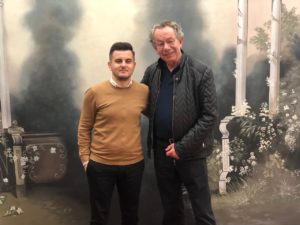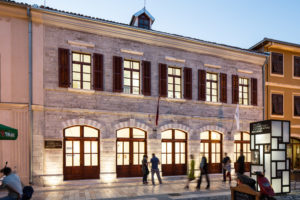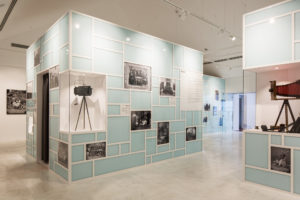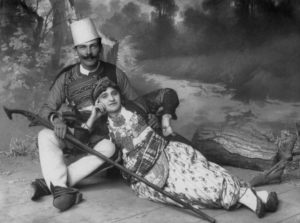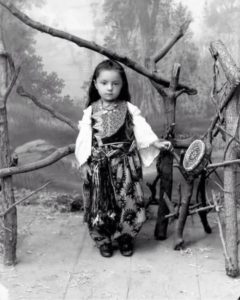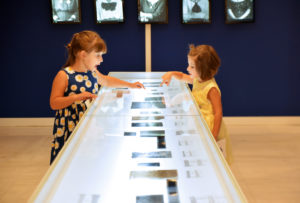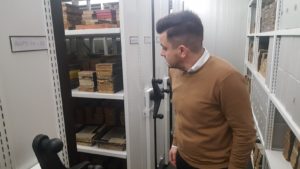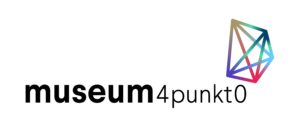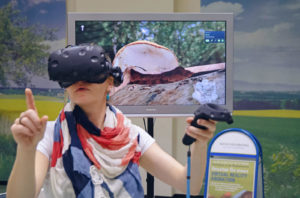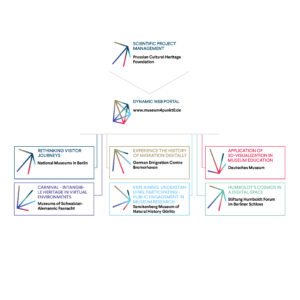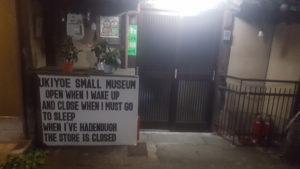Reports
A museum can change a city:
The Marubi National Museum of Photography in Shkoder, Albania
(September 3, 2020)
Even before the lockdown due to the corona pandemic, Dr. Michael H. Faber, President of AVICOM, had the opportunity to meet Lucjan Bedeni, the young and creative director of the Marubi Museum in Shkoder, Northern Albania.
The museum houses one of the most important ethnographic and socio-political photo collections in Central Eastern Europe, sets standards in conservation and restoration of old photographic material, and in communicating with the public. The photo collection is accessible worldwide via an online database.
For Michael H. Faber the visit to Shkoder was also the first contact with the Albanian National Committee of ICOM. A closer cooperation is planned.
Lucjan Bedeni meets Michael H. Faber in front of a historical photo studio wall. ©: Marubi Museum
The Marubi National Museum of Photography is the first museum of photography in Albania, one of the richest in the Balkans region and Europe with an archive of over 500.000 negatives in a period of time ranging from the end of the 19th century to end of the 20th century.
In December 2011, the Albanian government granted a fund to buy a building in the central pedestrian street of the Shkodër. In 2013, the European Union together with the Albanian government granted a fund for the Restoration and Musealization of the former “Marubi” Phototeque, now Marubi National Museum of Photography. In 2014, the Albanian Development Fund together with the Albanian Ministry of Culture launched a competition for the selection of the architectonic study for the project of the Restoration and Musealization. The winner was the Dutch studio Casanova & Hernandez. On May 9, 2016 the new Marubi National Museum of Photography was inaugurated. The museum is under the direct supervision of the Ministry of Culture.
The museum building in the pedestrian area of Shkoder. ©: Marubi Museum
The architectonic project implemented aims to start a dialogue between the past, the present and the traditional through the restoration of the historical building maintaining the same elements and spaces without transforming its dimension. The modern intervention was translated into 3 thematic rooms dedicated to the three masters of photography from the Marubi dynasty: Italian Pietro Marubi, who started the art of photography by opening his first photographic studio in Shkoder, his adopted son Kel Kodheli (Marubi) and the last of the dynasty Gege Marubi who was obliged to donate the archive to the communist regime.
The permanent exhibition. ©: Marubi Museum
The space is divided into two floors: the ground floor for temporary exhibitions and the first floor for the permanent exhibition. One of the most important spaces are the digitalization room and the archive where all the collections and new donations made to the museum from personal archives of other photographers are kept.
For the first time, the digitalization process started in 2013 in cooperation with UNPD Albania and the Region of Friuli Venezia Giulia. Over 100.000 glass negatives have been digitalized. The process is still in progress and the result for the first digitalized photographs can be viewed on the website www.marubi.gov.al with specific data about each photograph as founded on the old registers of the Marubi Phototeque.
The organization of the space, photographs, documents and artifacts exhibited serve the public function of the museum and the influence it aims to have in the city. All is represented in the slogan: “A museum can change a city”. This is an inspiration to the first of the dynasty, Italian Pietro Marubi, who came a way long from Italy to stop in Shkoder and found his studio. The first of the Marubi and the generation of photographers were not just taking studio photographs, but constantly moving through the city, throughout Albania and other nearby country to bring “to light” important moments, portraying people and events of various social classes. Their mission will be continued by the new Marubi which aims to go to the community and build a community around itself in order to sensitize generations about a common cultural and historical heritage through the images of people, landscapes, architecture, events, tradition, costumes.
Man and woman from Shkodra, P. Marubi 1879 / Child, P.Marubi 1880. ©: Marubi Museum
This is why the new museum is building intergenerational programs to make old and young generation come together, build a memory of the past and keep it alive to the present. In order for this to happen, proper educational programs are being built for primary education- workshops with children-high schools-students to be engaged in the digitalization and cataloguing processuniversities-training programs for museum guides, reception and activities assistance- in partnership with public and private institutions.
Children discovering the collection. ©: Marubi Museum
The museum will have its “Marubi Editions” program, a continuation of the last years editions, which will result not only in publications from the photographers of the archive, but also in a particular yearly edition about the study of photography according to the topic chosen by the editor. This would be the first study of this type to be published in Albania.
As an institution, the new Marubi museum sees itself as part of an important network of the city museums of Shkoder, which is a unique case in Albania, a city which tells its history from ancient to modern times through museums. The artifacts of the museum are unique pieces of our cultural heritage which together with the large national patrimony, constitute an important passport of the Albanian culture.
How will people explore, learn, and participate in museums in the future — and how can digital technologies support them?
A so far unique German project develops and tests digital strategies…
(May 28, 2020)
© Senckenberg Museum. Photo: Anke U. Neumeister
How can museum content be customized to match individual visitors’ needs? When do augmented and virtual reality channel knowledge creation? How can museum-based research come alive? How can cultural heritage be conveyed digitally? And how can digital applications be sustainably maintained, even with a small staff?
In six exemplary sub-projects, the German project museum4punkt0 focuses on issues surrounding the use of digital technology in museums. In the process, the project develops new formats and digital prototypes for education, knowledge transfer, participation, and communication. At the same time, museum4punkt0 is facing the challenges that using digital technology poses for staff, infrastructure, and workflows.
The German project museum4punkt0 connects seven cultural institutions from different regions in Germany. Across institutional borders, they have joined together to test digital products for new types of learning, experiencing, and participation in museums.
The project seeks to enable visitors to connect and actively engage with museums and their collections and allow for a personalized museum experience. Therefore, the project analyzes under which conditions digital applications and formats can support these goals.
Within the joint project, the partners foster a close exchange on questions regarding technological as well as structural requirements and standards for the development, implementation and maintenance of digital applications.
Project partners:
Prussian Cultural Heritage Foundation – National Museums in Berlin; German Emigration Center, Bremerhaven; Deutsches Museum, Munich; Swabian-Alemannic Carnival Museum “Narrenschopf”, Bad Dürrheim together with Carnival Museum Langenstein Castle; Senckenberg Natural History Museum, Görlitz; Stiftung Humboldt Forum, Berlin.
Find out more:
https://www.museum4punkt0.de/en
AVICOM supports ICOM and ICOMOS in call to allow the use of Nitrogen for the protection of cultural heritage
(Jan. 8, 2020)
Our letter to:
European Commission DG
SANTE Unit E.4 – Pesticides and Biocides F101 05/068
1049 Brussels, Belgium
Paris, January 8, 2020
Appeal for the cultural heritage collections: Allow a derogation of the nitrogen ban (EU 528/2012)
Memory institutions, museums and monuments are frequently challenged by pests due to various forms of contamination and changing climatic conditions.
One of the most versatile and environmentally friendly methods, where the use of hazardous chemicals is avoided, for disinfection purposes are “anoxia” or controlled atmospheres with an extremely low content of oxygen in treatment chambers where nitrogen is generated in situ for anoxic insect disinfestation of cultural heritage objects.
The EU legislation issue
Since the mandatory registration of the use of nitrogen for disinfection purposes by the biocidal products regulation EU 528/2012 in September 2017, only one method of using nitrogen (along with several other restrictions) was acknowledged and included: nitrogen in canisters. In situ generated nitrogen fell out. The nitrogen ban is not justified for health aspects and economically damaging the market of European stakeholders in the integrated pest management (IPM) business.
Because of this juridical flaw, existing anoxia facilities in Europe can no longer be operated legally. As a result, cultural heritage institutions are facing an acute danger of damage or irretrievable loss.
I therefore strongly urge the Commission to allow for a derogation under art. 55(3) in the BPR to be granted those Member States applying, because this method allows any material to be safely treated, contrary to the alternatives. In situ generated nitrogen is harmless, the most economic and environmentally friendly alternative to the presently allowed use of nitrogen for this purpose.
I look forward to hearing from you on this important matter.
Sincerely
Dr. Michael H. Faber, President of AVICOM
AVICOM participated in „Revolution: Velvet x Digital. 30 Years of Digital and Social Media in Museums“, November 6-7, 2019, Bratislava
(Dec. 16, 2019)
In 2019, the countries of the former Socialist Block commemorate th 30th anniversary of the Fall of the Iron Curtain. This Fall had not only connected two different worlds but also facilitated a fast exchange of information and experience among museum professionals. The conference „Revolution: Velvet x Digital“, organized by the Slovak ICOM Committee with support by the Austrian and Czech ICOM Committees and others, reflected the developments in the field of Digital and Social Media in Museums since the last 30 years, with a view to the future.
AVICOM took part with two contributions: Under the title „No Future without Instawalk and Virtual Reality?“ Michael H. Faber, President of AVICOM, presented some provocative theses about sense and nonsense, use and abuse of New Media in the museum context. Prof. Dr. Janos Tari, former President of AVICOM, gave a report on „Visual Trends in the Award-Winning Museum Projects of the AVICOM f@imp Festival (Festival of Audiovisual International Multimedia Patrimony).
ICOM Kyoto 2019: AVICOM Sessions were well attended
(Dec. 16, 2019)

© Photo: Michael H. Faber / AVICOM
24 lectures in five sessions, concrete decisions at the meeting of the newly elected board for the next term of office as well as an eventful offsite meeting with excursion Osaka: This is the track record of AVICOM in Kyoto.
In the first session, dedicated to the topic “AVICOM – Change of Duties in a World of Changing Communication”, Michael H. Faber (Germany) and Ildikó Szabòne Fejes (Hungary) discussed the tasks of the IC in the future. Janós Tari (Hungary) presented media developments during the history of AVICOM „f@imp“ festival.
In two further sessions, media innovations in the areas of documentation, restoration / reconstruction and communication with the public were presented.
Subsequent sessions focused on aspects of sustainability of digital databases and abilities to use media for barrier reduction and inclusion.
With an average of 40 participants, all sessions were well attended. The lectures will be published in a book on demand. Informations: avicom.mini.icom.museum.
Offsite meeting in Osaka: Around 20 guests visited to NHK TV Studio and to Sakai City Museum where they could plunge, with headsets, into the virtual reality of the Emperors‘ mausoleums.
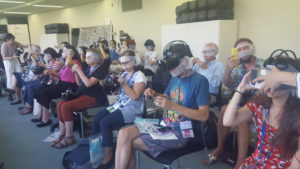
Osaka, Sakai City Museum: Participants exploring the virtual reality of Emperors‘ mausoleums © Photo: Michael H. Faber / AVICOM
Topics for the next years: Use of Social Media and Applications, Virtual and Augmented Reality for reconstruction and mediation of cultural heritage, barrier reduction and inclusion by media as well as legal aspects of digitalization.
Discovered in the Old Town of Kyoto: another type of museum… © Photo: Michael H. Faber / AVICOM
